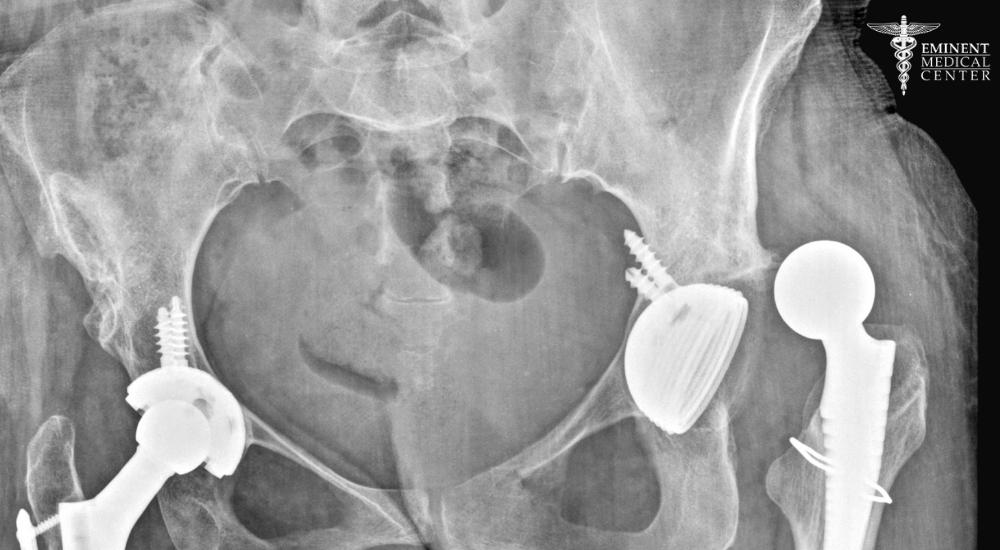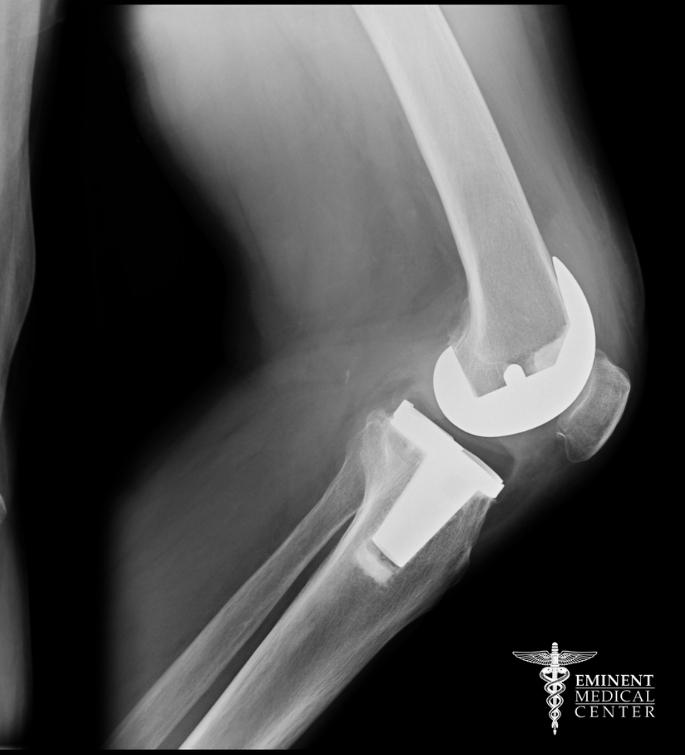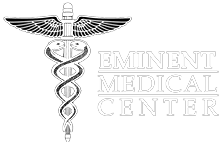Revision Joint Replacement Surgery in Dallas and Richardson, TX
At Eminent Medical Center, we proudly offer advanced revision joint replacement surgery in Dallas and Richardson for patients who are experiencing complications or discomfort after a prior joint replacement. Whether you’re dealing with a failed knee replacement implant, hip joint instability, or excessive scar tissue, our experienced orthopaedic surgeons perform this highly specialized surgical procedure using the latest surgical techniques and specialized implants.
Unlike your initial surgery, a revision procedure often involves correcting implant failure, addressing significant bone loss, or replacing an artificial joint that no longer functions as it should. Common signs that you may require revision surgery include severe pain, swelling, knee instability, or reduced range of motion in the knee joint or hip joint.
Our DFW total joint surgery team is committed to helping patients regain mobility, relieve pain, and return to daily life through a carefully planned recovery process that includes physical therapy and personalized care. If you’re considering a second surgery after total joint replacement, call Eminent Medical Center today at 469-910-8800 to learn how we can help restore your comfort and function.
What is Revision Joint Replacement Surgery?
Revision joint replacement surgery is a specialized surgical procedure performed when a previous joint replacement, such as a knee replacement or hip replacement surgery, no longer functions properly. Unlike the initial surgery, which replaces a damaged joint with an artificial joint, a revision procedure involves removing the existing implant, which may have loosened, worn down, or caused complications, and replacing it with a new, often more complex, joint replacement implant.
Patients may need this type of joint revision surgery due to implant failure, significant bone loss, infection, periprosthetic fractures, or other issues like excessive scar tissue or persistent pain. Due to the challenges involved, such as damaged bone surfaces, compromised soft tissue, or proximity to nerves or blood vessels, revision joint surgery is often more complex than the initial procedure. It requires a highly skilled surgical team, advanced planning, and specialized implants to restore stability, mobility, and comfort.
Signs You May Need Revision Joint Replacement Surgery
Recognizing when you may need joint revision surgery is essential for preventing further damage and restoring mobility. While joint replacement surgery is often one of the most successful procedures for relieving chronic joint pain, complications can develop months or even years after the initial surgery.
Whether it’s a knee replacement, hip replacement, or another type of joint surgery, certain warning signs may indicate that your artificial joint is no longer functioning as intended. These symptoms may cause discomfort and lead to long-term issues such as significant bone loss, damage to surrounding soft tissue, and reduced range of motion.
If you’re beginning to experience pain again or have concerns about your knee joint or hip joint, it’s important to speak with an orthopedic specialist at Eminent Medical Center.

Types of Arthrodesis Performed at Our Richardson and Dallas Surgical Facility
Spinal Fusion
Common types of spinal arthrodesis in Richardson and Dallas include:
SI Joint Fusion
The most common reason for spine arthrodesis is SI joint fusion. SI joint fusion is a surgical procedure designed to treat pain caused by conditions affecting the sacroiliac joints. During the procedure, the surgeon fuses the sacroiliac joints with plates, screws, and grafts, which connect the sacrum at the base of the spine to the iliac bones. This spine surgery eliminates movement in the sacroiliac joints and helps to alleviate pain that has not responded to other treatments like physical therapy. For those seeking SI joint fusion in Dallas and Richardson, this procedure is an effective option to restore stability and reduce discomfort caused by sacroiliac joint dysfunction.
Other types of spine arthrodesis in the DFW area include:
- Cervical fusion involves the vertebrae in the cervical spine and is typically used for degenerative disc disease, herniated discs, spinal fractures, or instability.
- Lumbar fusion is performed in the lumbar spine and is often used for degenerative disc disease, spondylolisthesis, or spine instability.
- Thoracic fusion involves fusing the vertebrae in the thoracic spine. It may be performed for spinal tumors, fractures, or scoliosis.
- Anterior lumbar interbody fusion (ALIF) is performed through the front of the body and is typically used for degenerative disc disease or disc herniation.
- Posterior lumbar interbody fusion (PLIF) is performed through the back and involves removing a damaged disc and inserting a bone graft to stabilize the spine.
- Transforaminal lumbar interbody fusion (TLIF) is similar to PLIF, but performed through a slightly different approach.
- Minimally invasive spinal fusion uses smaller incisions and specialized tools to reduce tissue damage and shorten recovery times compared to open surgery.
Hip Fusion
Hip arthrodesis fuses the bones in the hip joint to relieve chronic pain and improve stability, often when other treatments have failed. While effective, it carries risks such as stiffness and complications at the fusion site. Patients considering hip fusion in Richardson and Dallas should consult with their healthcare provider to determine if it’s the best treatment option for their condition.
Knee Fusion
The knee arthrodesis procedure involves fusing the knee joint to eliminate motion and provide long-term pain relief, offering a stable solution for patients suffering from severe arthritis or traumatic injuries. During the procedure, screws and plates are used to secure the two bones together. For those considering knee fusion in Richardson and Dallas, consult with a healthcare provider to determine if this procedure is the best option for your pain or symptoms.
Ankle Fusion
Ankle arthrodesis is a surgical procedure used to treat chronic pain and instability in the ankle. During the procedure, bone grafts, screws, and plates are used to fuse the joint. For patients in need of relief from severe symptoms, ankle fusion in Richardson or Dallas is an effective surgical option. Consult with a healthcare provider to determine if ankle arthrodesis is the right choice for you.
Wrist Fusion
Wrist arthrodesis is a procedure used to treat chronic pain and instability in the wrist. During the procedure, screws and plates are used to join the bones together. For patients in need of wrist arthrodesis in Dallas or Richardson, it’s important to consult with a healthcare provider to determine if this procedure is right for relieving symptoms and restoring function.
Shoulder Fusion
Shoulder arthrodesis, or arthrodesis surgery, is used to fuse the shoulder joint for patients with severe pain or instability. During the procedure, screws are used to secure the joint. For patients considering shoulder arthrodesis in Richardson and Dallas, consulting a healthcare provider is essential to determine if this surgery is the best option.
Common Types of Revision Joint Replacement Surgery in Richardson and Dallas, Texas
At Eminent Medical Center, we perform several types of joint revision surgeries, each tailored to the joint and the patient’s needs. Whether you’re dealing with a failing knee replacement implant, complications after hip surgery, or issues with another artificial joint, our experienced orthopaedic surgeons use advanced surgical techniques and specialized implants to address even the most complex procedures.
Every revision surgery requires thorough planning, often involving detailed imaging, laboratory tests, and evaluation of soft tissue, bone loss, and implant failure. The most common types of revision procedures include knee revision surgery, hip revision surgery, and, less frequently, revisions of shoulder, ankle, or elbow replacements.
Knee Revision Surgery
Revision knee surgery, also known as revision knee replacement or revision total knee arthroplasty, is performed when a total knee replacement no longer provides adequate function or comfort. Causes for this procedure may include knee instability, wear of the plastic liner, excessive scar tissue, or loosening of the existing implant.
The revision typically involves removing old components, preparing bone surfaces, and implanting more durable parts. If the patient has significant bone loss, surgeons may use specialized implants or bone grafts.
If your knee replacement has failed or no longer provides relief, Eminent Medical Center offers advanced solutions, including MAKO total knee replacement in Richardson and Dallas. This cutting-edge technology allows for greater precision and a more personalized fit, helping you get back to moving comfortably and confidently.
Hip Revision Surgery
Hip revision surgery is often necessary when a hip replacement fails due to loosening, infection, or a periprosthetic fracture. During this complex procedure, the surgeon removes the worn or damaged artificial hip components and replaces them with new parts designed to better support the hip joint.
Depending on the situation, complex surgical techniques may be necessary to address broken bones, scar tissue, or compromised blood vessels and nerves. Post-operative recovery typically involves physical therapy, blood clot prevention, and careful monitoring to prevent potential complications.
If your previous hip replacement is no longer working as it should, consider the benefits of a MAKO total hip replacement in Richardson and Dallas at Eminent Medical Center. This advanced technology allows for greater accuracy, better implant alignment, and a smoother recovery so you can get back to living without pain.
Other Joint Revision Surgeries
While the knee and hip are the most common sites for joint revision surgery, other joints may also require revision surgery. Shoulders, elbows, and ankles are less frequently involved but still prone to implant failure, joint instability, or issues stemming from soft tissue deterioration. These procedures often require specialized expertise tailored to the joint’s unique biomechanics.
At Eminent Medical Center, our team uses advanced imaging, current surgical techniques, and post-operative rehabilitation, including sports medicine support and rehabilitation center resources, to help patients recover fully from joint revision surgery.
How Revision Joint Replacement Surgery Differs from Initial Joint Replacement Surgery

Revision joint replacement surgery differs significantly from initial joint replacement surgery in complexity and approach. While the first procedure typically involves replacing a damaged joint with a new artificial joint, a revision procedure must address the challenges of removing an existing implant, which may be loose, worn, or surrounded by excessive scar tissue.
Surgeons often encounter significant bone loss, compromised soft tissue, or damaged nerves or blood vessels, requiring more difficult surgical techniques and the use of specialized implants to rebuild and stabilize the joint.
Unlike the more straightforward joint replacement surgery, revision operations are performed in a highly controlled operating room setting. They often have longer surgical times and greater attention to preventing blood clots and other potential complications, like infection or lung complications. The recovery process is also more involved, often requiring extended physical therapy and rehabilitation to restore strength, mobility, and pain relief.
Preparing for Revision Knee Replacement or Hip Replacement Surgery
Preparing for revision knee replacement or hip revision surgery begins with a thorough evaluation by your orthopedic surgeon to determine the cause of implant failure and plan the best course of action. This may include advanced imaging, laboratory tests to rule out infection, and assessments of bone loss, joint fluid, and the condition of surrounding soft tissue. Your medical team will also review your full health history to minimize the risk of blood clots, chest pain, or other potential complications during and after the surgical procedure.
If you’re undergoing surgery due to a loosened knee replacement implant or worn artificial hip, your surgeon may order custom or specialized implants to ensure a secure fit and better long-term outcomes. You may also begin physical therapy ahead of the procedure to improve joint strength and flexibility, helping your body better tolerate the second surgery and shorten your recovery process. For patients with excessive body weight, weight management may be recommended to improve surgical results and reduce pressure on the knee joint or hip joint.
What to Expect During Revision Joint Replacement Surgery in Dallas and Richardson
During revision joint replacement surgery at Eminent Medical Center, you can expect a more involved and customized procedure than your initial surgery. The joint revision surgery begins with the careful removal of the existing implant. This process often requires the surgeon to address significant bone loss, excessive scar tissue, or damage to surrounding soft tissue, nerves, or blood vessels.
Once the old components are removed, the surgeon prepares the bone surfaces and installs new, often specialized implants designed to provide a secure, long-lasting fit. In some cases, the surgeon may use bone grafts or structural supports to rebuild areas where healthy bone has deteriorated. The surgical team will also take steps to prevent blood clots, manage bleeding, and monitor for any signs of infection or lung complications.
Because revision procedures are more complex, the surgery may take longer, and you’ll likely spend additional time in the operating room and post-op recovery area. However, our goal remains to restore function, improve mobility, and help you achieve complete pain relief through advanced joint revision surgery.

Recovery After Joint Revision Surgery at Eminent Medical Center
Recovery after joint revision surgery at Eminent Medical Center supports healing, reduces complications, and helps you return to daily activities with improved function and comfort. Whether you’ve undergone revision knee surgery or hip revision surgery, the recovery process typically begins with a short hospital stay for monitoring, pain relief, and blood clot prevention. Our team will assess your vital signs, check for joint fluid buildup, and begin early movement protocols to minimize the risk of lung complications and promote circulation.
Once stable, you’ll begin a personalized physical therapy program guided by a licensed physical therapist. Therapy focuses on restoring range of motion, rebuilding strength around the knee joint or hip joint, and improving balance and flexibility.
Recovery from joint revision surgery can take longer than recovery from the initial surgery due to the complex procedure, specialized implants, and possible significant bone loss. However, with proper care and commitment to your rehab plan, many patients regain mobility and experience lasting pain relief after their second surgery.

Risks and Potential Complications of Revision Joint Replacement
While joint revision surgery can offer lasting pain relief and restore mobility, it is considered a complex procedure and carries a higher risk of complications compared to the initial surgery. Some of the most common potential complications include infection, blood clots, lung complications, and delayed wound healing.
Because revision surgery often involves removing an existing implant, addressing significant bone loss, and working around soft tissue, nerves, or blood vessels, the procedure requires more time in the operating room and greater surgical precision.
Other possible risks include implant failure, dislocation, limited range of motion, excessive scar tissue, and fractures around the implant, known as periprosthetic fractures. Patients with excessive body weight, poor bone quality, or chronic health conditions may face additional challenges.
Despite these risks, when performed by experienced orthopaedic surgeons using modern surgical techniques and specialized implants, revision surgery at Eminent Medical Center remains one of the most successful procedures to treat failed joint replacements.
FAQs for Joint Revision Surgery in Dallas and Richardson
How Long Do Knee or Hip Replacement Implants Last?
Most knee and hip replacement implants last between 15 and 20 years, but this can vary depending on factors like activity level, overall health, and implant type. When an implant wears out, loosens, or fails earlier than expected, revision joint replacement surgery may be necessary to restore joint function and relieve pain.
How Do I Know If I Need a Knee Replacement Implant Revision?
If you’re experiencing persistent pain, swelling, stiffness, or instability after your original knee replacement, you may need a revision knee replacement implant. Other warning signs include a limited range of motion, a loosening sensation, or changes in how your knee joint feels or functions during daily activities.
How Do I Know If I Need a Hip Revision Surgery?
You may need hip revision surgery if you experience sudden pain, swelling, reduced mobility, or a feeling that your hip joint is unstable or dislocated. Additional signs include a loosening or clicking sensation in the artificial hip or symptoms of infection, like redness, drainage, or fever.
Is Revision Joint Replacement More Painful Than the First Surgery?
Revision joint replacement surgery can involve more discomfort than the initial surgery due to the complex procedure, longer recovery time, and the need to address issues like scar tissue or bone loss. However, with proper pain relief, skilled surgical care, and dedicated physical therapy, many patients find the recovery manageable and well worth the improvement in mobility and comfort.
Can Physical Therapy Help Delay the Need for Revision Surgery?
While physical therapy can help improve strength, mobility, and manage discomfort in the short term, it cannot correct problems like implant failure, knee instability, or significant bone loss. If you’re still experiencing pain or limited movement despite therapy, revision joint replacement surgery is often the most effective solution for long-term relief and restored joint function.
Why Choose Eminent Medical Center for Your Revision Joint Replacement Surgery in Dallas and Richardson, TX?
At Eminent Medical Center, we specialize in revision joint replacement surgery for patients experiencing implant failure, scar tissue, or significant bone loss after a previous joint replacement. Our experienced orthopaedic surgeons use advanced surgical techniques, specialized implants, and personalized care plans to restore mobility and provide lasting pain relief.
